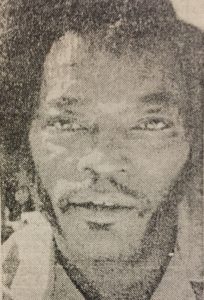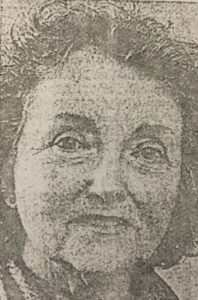Feb. 3, 2020
Hello everyone,
The Final Edition began on Nov. 25, 2016, and ends today — I’m out of stories.
Thanks for reading. The Final Edition has received well over 100,000 hits, more than 1,500 hits a week for the last few months.
It’s been fun but it’s been time consuming, too, and I’m ready to move on. I want to learn how to cook, tie knots, identify trees, get better at horseshoes. And get in shape for a 75-mile and a 55-mile hike this spring.
Many, many thanks to people have written stories or made videos for the blog or helped with research or editing.
My wife, Donna Hyland Stith, Brother Dave Stith; Sister Alene Lambert; Grandson Christian Stith; Niece Pam Stith; Nephews Steve Lambert and Chuck Stith; and Nate Harrington, Tommy Killebrew, Wayne Lewis, Pat Stumpf and Rob Waters. Many others have contributed photos or documents or helped with with editing [Granddaughter Chelsea Waddelow, and Andy Curliss] or research [Nephews Paul Stith and Steve; Brother-in-law Ed Hyland; Brooke Cain and Teresa Leonard] or helped me with various technical problems — Christian and, of course, Dave, who designed the blog. I hope I haven’t inadvertently left someone out.
Today is the 358th post and I’m pretty proud of the fact that, with Dave’s assistance from time to time, I have posted on time 99.4 percent of the time.
I intend to post more stories occasionally, once a month maybe, on an irregular basis. I love stories and I’ll always be on the lookout for good ones.
I wish you would do me a favor. For the most part I have no idea who has seen my stories. Who are you? Sent me a quick note to Pat@StithNC.Com. Better yet, tell ME a story.
I saved one of my favorites for the final. Here it is, “The Court Of Last Resort.”
* * *
I came to think of The News & Observer as the court of last resort when I worked there as an investigative reporter. When people with a problem had tried everything else, without success, they would pick up their telephone and call my newspaper.
Gloria Kornegay’s call was transferred to me.
Her brother had been convicted of robbing a liquor store in Oak City, 90 miles northeast of Raleigh, and sentenced to 18 years in prison. She told me he was innocent and she wanted me to prove it.

I was paid to listen to people like Ms. Kornegay. But the chances I would even try to get her brother’s conviction overturned were slim and none. Whether James Edward Thompson was innocent really didn’t matter if I couldn’t prove it, or at least raise serious doubts about his conviction, and that had to be a 1 in 100 shot. I don’t like odds like that.
But I listened and what she told me was intriguing.
At the conclusion of her brother’s trial, after the jury returned guilty verdicts against him and two co-defendants, one of the co-defendants made an unusual statement to the court: Thompson had not helped rob the liquor store –– he didn’t even know Thompson. The man hadn’t tried to clear Thompson during the trial because it would have meant admitting his own guilt.
I was also bothered by the fact Thompson’s conviction was based solely on the testimony of three eyewitness, customers who were in the store when it was robbed. A lot of people, most people, I guess, would say that’s the ball game — three eye witnesses couldn’t all be wrong. But I don’t have complete confidence in eye witness accounts. I had covered courts for a couple of years early in my career and –this shouldn’t surprise you — sometimes eye witnesses make mistakes. Sometimes they lie. I also had a lot of first hand experience with eye witnesses in my own work — they are not always reliable and that’s all there is to it.
I interviewed all three eye witnesses in this case and I want you to see what one of them told me, in an on-the-record, tape recorded, interview:
“I had three darkies, working in the country, in Kentucky off and on,” he said. “And I don’t know whether you know it or not, but, really, you get ’em all three together, they’re hard to identify.”
The witness was white; Thompson and his two co-defendants were black.
I’m not going to recount all the who-shot-John of my investigation, who I talked to, what they told me. That story was published in The N&O on Feb. 24, 1985. This story has never been published.
* * *
I never prayed for success in my work because I just didn’t think that was the right thing to do.
Stories I wrote usually embarrassed somebody. Sometimes, pretty often, they lost their job. In a few instances they went prison. It didn’t just seem right to ask for God’s help on stories that bought people so much unhappiness.
I did, however, pray about the Thompson story, and here’s why: When I sat down to write I was pretty sure Thompson had been wrongly convicted, but I wasn’t positive. So I prayed: If Thompson was innocent I asked God to make people see in my story proof of his innocence, and if he was guilty, for people to dismiss my story as claptrap.
And then I began to write.
Writing, editing, rewriting an investigative story can take days, sometimes a couple of weeks. Sometimes the top editors and the newspaper’s libel attorney get involved. But not this time. The Thompson story was the easiest investigative story I can remember ever writing. The editing was a snap too and, just like that, it was done.
* * *
My story caused the State Bureau of Investigation to reexamine its role in the case. It generated offers of help from across the state, including attorneys who offered their services pro bono, and it helped get Thompson a new trial.
A few weeks after my story was published I covered the hearing on Thompson’s motion for a new trial. During a recess a young man approached me and said his mother wanted to meet me, and he pointed toward the back of the courtroom where she was sitting.
I thought she wanted to thank me for the job I had done, and why not. It was a pretty piece of work if I do say so myself. Others thought so too: The story won first place in investigative reporting in a contest sponsored by N.C. Press Association that year.
So I walked to the back of the courtroom, said hello, and was mildly surprised when she didn’t begin telling me what a wonderful job I had done.
Instead, she told me that she was the leader of a Bible study in the prison where Thompson was still being held — he was a member of her Bible study. At first, she said, he was bitter toward his co-defendants, who could have cleared him if they had not been so focused on trying to save themselves. But, gradually, she said, he forgave them and he and the other men in the Bible study began praying for his release.
“We did not know who God would send,” she told me, “but we knew He would send someone.”
Postscript: Three months later Thompson was retried and found not guilty.
